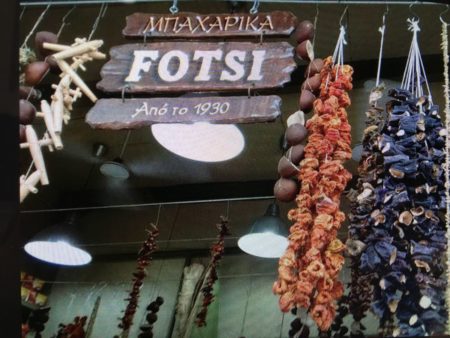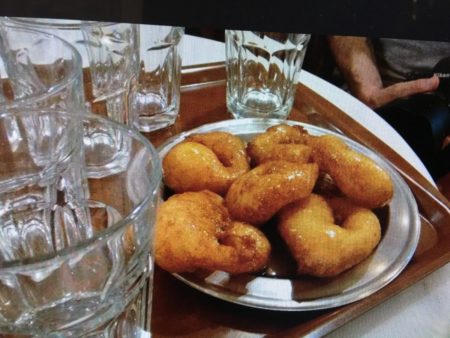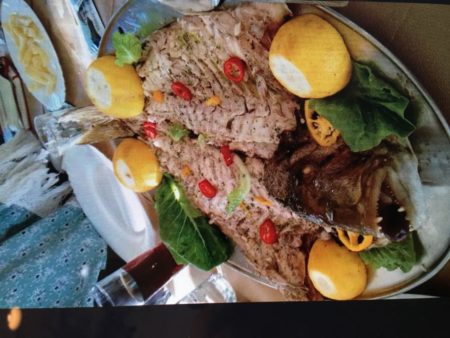The thieves were afoot and quick to act. Like Roman conquerors prowling the ancient Greek city-states of the Mediterranean, they shamelessly scooped up what the benevolent muses delivered. Brightly painted yellow chairs against the turquoise water and deep blue sky of a seaside café. Gone. Byzantine hymns floating from rock-faced monasteries perched high above ripening vineyards and olive groves. Vanished into thin air. They snatched away the subtle flavors of cheese pies, stuffed zucchini flowers, roasted goat meat and exquisite sinagrida fish.
The perpetrators had a diabolical plan. As swiftly as Pegasus, the mythical flying horse, the bus driver whisked my friends and I around hairpin turns. The mayors welcomed us to their cities. The guides pushed us along. “Five more minutes, people!” Panagis calls. There was no time to linger. At every vista there was a new adventure to expunge the last unrecorded memory.
No less brazen were the thugs who shattered the perpetual youth of the nude twin warriors who stood before me at the Archaeological Museum of Corinth. Their severed heads reattached and broken limbs reassembled, they stood guard once again on an earthquake-proof pedestal and embodied the ancient Greek ideal of physical beauty.
Yet it almost didn’t happen. In the spring of 2010, authorities had seized the broken parts of the unique statues from antiquity smugglers at the nearby village of Klenia. Known as “Kouroi,” the plural form of the Greek word “Kouros” meaning a male youth, especially of noble rank, the word has come to mean the statues themselves. I stood on tiptoes and peered into the two limestone boxes set beneath the stone warriors.
“Yes, those are the actual bones of the boys.” Our museum guide anticipated my question before I even asked. “No pictures of this exhibit, please.”
The boys, I thought. Images forbidden. There was almost a possessive, even parental, tone regarding the masterpieces. Indeed, dental analysis of the remains showed that the young men were no more than thirty five years old when they died around 550 B.C., possibly in battle between powerful Corinth and one of the other constantly warring city-states around the Corinthian gulf region.
The twins would have been well known at the time and their remains were placed into two sarcophagi at a prominent point in the landscape. Carved into the finest marble, the frozen youthfulness of the tragic figures overlooked the rest of the extensive cemetery. But there is no eternity for empires and eventually civilizations topple, as did the statues. The earth encapsulates collective memory waiting for the day when it might be unwittingly released under a farmer’s plow blade or a heavy rainstorm.
The gods of time are fickle, however, and history can be sold to the highest bidder. The looters had broken the Kouroi into parts as they dragged them out of the ground. I saw the repaired gashes across one warrior’s chest, the other’s nose scraped off as if battle scarred.
Ironically, the uncompromising Greek regulations designed to protect the country’s heritage and prevent antiquity smuggling may do just the opposite. The land is littered with the remnants of previous cities and cultures. Modern housing sits atop veritable treasure. An old silver coin may pop up in a homeowner’s spring garden as commonly as a Greek salad on a dinner table. There’s a good probability that the excavation required for a new building’s foundation might unearth an antiquity.
By law, such findings must be reported to the Ministry of Culture. This action would trigger an archaeological study, putting a halt to the building process. If the study confirms a significant discovery, the compensation to the landowner falls far short of actual value and may even deprive the owner of his building site. Therefore, there is less motivation to report findings or to undertake projects at all. This is a problem for a struggling economy that needs investment in large infrastructure and private sector projects but ultimately depends on tourism and historical preservation.
The heartbreaking result of previously unchecked cultural looting on a larger scale is evident by simply looking up at the Acropolis in Athens. More than two thirds of the magnificent, carved marble frieze once encircling the Parthenon now resides in England, France, Italy, Germany and Austria, while the balance of the ravaged blocks sit under cover inside the Acropolis museum.
Throughout my journey around the placid Corinthian waters, I passed through the co-mingled layers of time and history. Next to the crumbling ruins of an Ottoman castle, we boarded a ferry and passed under the gleaming Rio-Antirrio suspension bridge finished just in time for the 2004 Summer Olympics in Athens. Figuratively digging through the Ottoman, Byzantine, Roman, Persian and ancient Greek civilizations, I saw each culture stealing, building, destroying, adapting from the others.
Along the way, I noticed that portrayals of Zeus, the archetypal Greek deity and king of the gods, started as an old, bearded man. Interestingly, as history progressed he became more youthful and virile in an idealized human sense. It was this youthful depiction of Zeus that I saw in the port town of Aigio. The figure in the flawless statue wore a medallion to protect against evil. But there was no secret amulet ever devised that could restrain those who were determined to loot memory.
MUSHROOM HUNTING TAKES A DARK TURN
The tourists all gone, the crisp air of autumn was already spilling down the mountain onto the red-tiled roofs and clock tower in Arachova. Village shops optimistically displayed colorful scarves and fur hats in sidewalk displays. Soon there would be skiers on the slopes of Mt. Parnassus, a mere two hours from Athens. But today we were taking advantage of the waning daylight and previous week’s rain by looking for forest mushrooms.
With each step, my sneakers pressed into the spongy trail. Thick, gray clouds swirled around towering Kefalonia fir trees, a species that grows only in this forest and on the island of Kefalonia. The real show was at our feet, however. Yellow petals of the fall-blooming saffron crocus poked through the moss and fallen leaves. Around each bend we saw a different variety of mushroom ranging in size from a thimble to a dinner plate, in color from pure white to burnt orange.
In total, 280 different kinds of mushrooms grow in the National Forest of Parnassus and we were seeing just a small sampling on this section of trail. It was perfectly legal to pick them – assuming you knew what was safe to eat. As one theory goes, the famed oracle of Delphi knew exactly what she was eating when hallucinogenic fungi induced her prophetic visions.
The more widely espoused explanation for the trances, however, is that the priestess inhaled a narcotic gas released from a fissure in the ground. Whatever the source of the visions, political leaders of the city-states traveled far and wide to Delphi to seek her advice before any major military decision.
I bent down and examined the mossy stone wall lining the 3500-year-old path to Delphi through the old-growth forest. Most of the assorted breadbox-sized boulders were still expertly fitted together as if stone masons had built the wall yesterday.
Soon we arrived at the edge of a deep canyon, the deepest in all of Europe, in fact. Some brush grew out of the almost vertical rocky walls but there were no discernible ledges and no path down.
Panagis, ever the playful leader, dislodged a small rock from the soil and threw it over the edge. “Be careful, everyone,” he called, “because if you fall, you never come back.”
As if I had been thrown over the cliff myself, a flood of memories washed over me. This was not my first time traveling in Greece, but during the past two weeks I had never laughed so much or thought about philosophical issues so deeply as with this current bunch of illogical, emotional Greek bandits who had stolen my heart. I couldn’t imagine saying goodbye tomorrow, let alone losing any one of them or my American friends to an accident.
But Panagis wasn’t joking this time. Several seconds later, I was startled out of my daydream by the sound of the rock hitting ice at the bottom of the ravine. Notwithstanding the distance that the reverberating sound must have traveled and the amazing fact that there was a permanently frozen stream deep inside a forest chasm in a Mediterranean climate, the secret that the canyon held was truly chilling.
During the Second World War, Nazis controlled their twisted narrative by throwing troublesome Greeks into the icy pit. Today, a warming climate occasionally spits out an intact human body and a piece of the story to rock climbers well equipped and brave enough to venture downward into the dark history.
All Greeks are storytellers and historians at heart insofar as their history and culture has shaped the rest of the world in so many ways. Their collective memory is long and far reaching. They are sympathetic to Syrian refugees because they remember a time when Greek refugees from Turkey fled to Syria. More than anything, they understand that words and stories are powerful vehicles for either good or evil. They can foment unrest and violence or they can be used to inspire people. Both cases have happened repeatedly in their history.
Of course no nationality can claim that they invented storytelling. Some people say that since the earliest drawings scratched on cave walls, the unique characteristic that set Homo Sapiens apart from all other creatures on earth is its ability to communicate experiences and to create complex stories. In ways that are still evolving, humans bank those memories not only in their minds but in a myriad of other ways expressed in art, music, literature and architecture. But they may also be the only species capable of willfully destroying those same memories.
***************************************
David Lee Drotar’s travel stories appear in Earth Island Journal, The Buffalo News and numerous other publications. Drotar is the author of seven books including Steep Passages: A World wide Eco-Adventurer Unlocks Nature’s Spiritual Truths (http://www.brookviewpress.com). He is the recipient of the 2016 Excellence in Journalism Award from the International Food, Wine & Travel Writers Association.
***************************************
IF YOU GO
For information on these areas in the Corinthian Riviera of Greece, see:
Corinth http://www.visitgreece.gr/en/destinations/korinthos
Ancient Corinth http://www.ancientcorinth.net/
Arachova http://arachova.gr/en/
For information on arranging a guided motor tour in the Corinthian Riviera, contact:
Tsotras Travel Services
Thiva, Greece
t: +30 22620 26444
f: +30 22620 26333
w: www.tsotrastravel.gr
e: [email protected]










